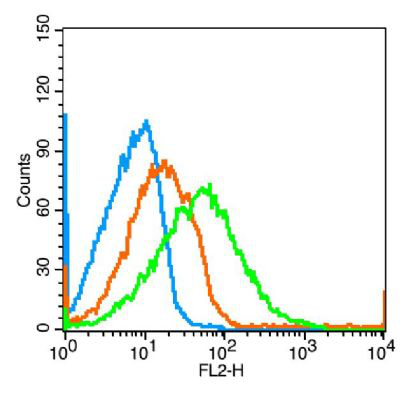产品货号 : mlR11181
英文名称 : Neuroligin 3
中文名称 : 突触细胞粘附分子3抗体
别 名 : Gliotactin homolog; Neuroligin3; Neuroligin-3; Nlgn3; NLGN3_HUMAN.
研究领域 : 神经生物学 细胞类型标志物
抗体来源 : Rabbit
克隆类型 : Polyclonal
交叉反应 : Human, Mouse, Rat,
产品应用ELISA=1:500-1000 IHC-P=1:400-800 IHC-F=1:400-800 ICC=1:100-500 IF=1:100-500 (石蜡切片需做抗原修复)
not yet tested in other applications.
optimal dilutions/concentrations should be determined by the end user.
分 子 量 : 82kDa
细胞定位 : 细胞膜
性 状 : Lyophilized or Liquid
浓 度 : 1mg/ml
免 疫 原 : KLH conjugated synthetic peptide derived from human Neuroligin 3:601-700/848 <Extracellular>
亚 型 : IgG
纯化方法 : affinity purified by Protein A
储 存 液 : 0.01M TBS(pH7.4) with 1% BSA, 0.03% Proclin300 and 50% Glycerol.
保存条件 : Store at -20 °C for one year. Avoid repeated freeze/thaw cycles. The lyophilized antibody is stable at room temperature for at least one month and for greater than a year when kept at -20°C. When reconstituted in sterile pH 7.4 0.01M PBS or diluent of antibody the antibody is stable for at least two weeks at 2-4 °C.
PubMed : PubMed
产品介绍 : This gene encodes a member of a family of neuronal cell surface proteins. Members of this family may act as splice site-specific ligands for beta-neurexins and may be involved in the formation and remodeling of central nervous system synapses. Mutations in this gene may be associated with autism and Asperger syndrome. Multiple transcript variants encoding distinct isoforms have been identified for this gene. [provided by RefSeq, Oct 2009].
Function:
Cell surface protein involved in cell-cell-interactions via its interactions with neurexin family members. Plays a role in synapse function and synaptic signal transmission, and may mediate its effects by clustering other synaptic proteins. May promote the initial formation of synapses, but is not essential for this. May also play a role in glia-glia or glia-neuron interactions in the developing peripheral nervous system.
Subunit:
Interacts with NRXN1, NRXN2 and NRXN3. Interacts (via its C-terminus) with DLG4/PSD-95 (via PDZ domain 3). Homodimer, and heterodimer with NLGN1 and NLGN2.
Subcellular Location:
Cell membrane; Single-pass type I membrane protein. Cell junction, synapse. Note=Detected at both glutamatergic and GABAergic synapses
Tissue Specificity:
Expressed in the blood vessel walls (at protein level). Detected in throughout the brain and in spinal cord. Detected in brain, and at lower levels in pancreas islet beta cells.
DISEASE:
Defects in NLGN3 may be the cause of susceptibility to autism X-linked type 1 (AUTSX1) [MIM:300425]. AUTSX1 is a pervasive developmental disorder (PDD), prototypically characterized by impairments in reciprocal social interaction and communication, restricted and stereotyped patterns of interests and activities, and the presence of developmental abnormalities by 3 years of age.
Defects in NLGN3 may be the cause of susceptibility to X-linked Asperger syndrome 1 (ASPGX1) [MIM:300494]. ASPGX1 is considered to be a form of childhood autism.
Similarity:
Belongs to the type-B carboxylesterase/lipase family.
SWISS:
Q9NZ94
Gene ID:
54413
Important Note:
This product as supplied is intended for research use only, not for use in human, therapeutic or diagnostic applications.
产品图片












